Cash Services
The Federal Reserve System issues and distributes the nation’s currency

One purpose for the establishment of the Federal Reserve System was to "to furnish an elastic currency." This brief statement at the beginning of the Federal Reserve Act reflects the historical economic importance of an adequate supply of currency for payments and as a store of value. The Federal Reserve issues and distributes currency in the form of Federal Reserve notes. The Federal Reserve provides cash services to ensure that cash (currency and coin) in circulation is sufficient to meet public demand. Cash remains an important means of payment, even as Americans have more widely adopted other forms of payments since the Fed's founding.
Cash Since the Early 1900s
In the early 1900s, currency in the United States consisted of a mix of instruments. National bank notes were issued by commercial banks chartered by the federal government. The US Treasury issued gold certificates, silver certificates, and United States notes.1 The Treasury made cash available to the public through facilities known as subtreasuries in nine major cities; these functions were transferred to the Federal Reserve in 1920 (Booth 1992). All of these forms of currency continued to circulate alongside Federal Reserve notes, first issued in 1914, until eventually being discontinued. In response to the Great Depression, the US government prohibited private ownership of gold certificates and gold coin in 1933 and the next year initiated the retirement of national bank notes, an action anticipated since the Fed's founding (Weber 2015). Silver certificates were retired beginning in 1963 amidst a rise in silver prices, and United States notes were finally eliminated in 1994 as Congress judged them "obsolete."
Federal Reserve notes quickly came to account for about half of total cash in circulation by 1918. The amount of currency accounted for by Federal Reserve notes fluctuated during the 1920s and early 1930s in line with the level of public demand for currency. As other forms of currency were discontinued, however, Federal Reserve notes have come to account for virtually all paper currency in circulation.2
Congress originally authorized Federal Reserve note denominations of $5, $10, $20, $50, and $100. Smaller denominations of $1 and $2 were not authorized until the 1963 retirement of silver certificates, which at the time carried denominations of $1, $5, and $10. Larger denominations of Federal Reserve Notes, of $500, $1,000, $5,000, and $10,000, were authorized in 1918 and used primarily for interbank transactions. The Fed stopped issuing these larger denominations in 1969, citing lack of demand and the wider use of checks.3
Federal Reserve notes are issued by the Board of Governors to the Reserve Banks, which distribute them to depository institutions. These notes are produced by the Department of the Treasury's Bureau of Engraving and Printing, which charges the Board for the cost of production. Federal Reserve Banks also distribute coins, which are issued by the United States Mint, a bureau of the US Treasury, and bought and sold by the Reserve Banks at face value.
Cash Services

Depository institutions use the Fed's cash services to acquire additional Federal Reserve notes as needed to meet demand, to replace unfit notes, to deposit excess currency, or to deposit denominations not typically used. Federal Reserve Banks pay and receive shipments of cash, verify and sort received cash, identify counterfeits and unfit notes, cancel and destroy unfit notes, and distribute new notes.
Until the Monetary Control Act (MCA) of 1980, only commercial banks had access to the Fed's cash services. The Fed charged non-member banks for transportation services, but has never charged for the issuing and processing of cash, as it is considered a governmental activity (Booth 1992). The MCA required the Fed to make available payment services, including cash services, to other depository institutions—savings banks, savings and loans, and credit unions—that otherwise used the cash services of correspondent banks (banks that provided financial services to other banks). The Act also required the Fed to charge for non-governmental services such as transportation or coin wrapping (Federal Reserve Bank of New York 1982).
Automation
For many years, counting machines were the only significant automation of cash services (Lacks 1960). The sorting and identifying of notes was still a largely manual task into the 1970s. An experienced sorter could reportedly process about 32 thousand notes per day (Federal Reserve Bank of Cleveland 1967). In comparison, check processing operations had become automated earlier with the adoption of magnetic ink by 1961.
In the 1960s, increased currency volumes prompted the Fed to invest in research and development of automation based on new technology. This effort culminated in medium-speed machines in the 1970s that automated some tasks. High-speed equipment that was first used in 1978 automated a broad range of tasks, including detecting counterfeits and automatically shredding unfit notes, and processed about 60 thousand notes per hour (Board of Governors 1988-1989). These machines were known as currency verification, counting, and sorting (CVCS) machines.
Soon after adopting CVCS machines, the Federal Reserve began developing another generation of machines. The new machines, known as the ISS-3000 and later as the Banknote Processing System BPS-3000, could process 100 thousand notes per hour. In 2016, the Federal Reserve initiated a process to develop and procure "NextGen" high-speed currency processing equipment. As of 2022, the Fed was anticipating testing of prototype equipment through 2024.
Automation has supported very large increases in the number of notes received and counted by the Fed, from 3.8 billion in 1950 to a peak of nearly 38 billion in 2007. This volume has since declined to about 30 billion in 2022.4
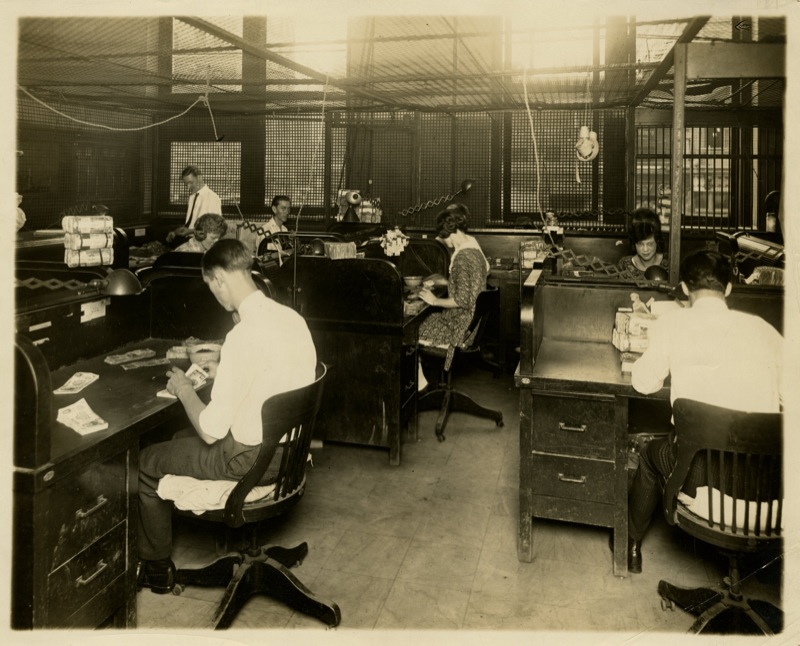
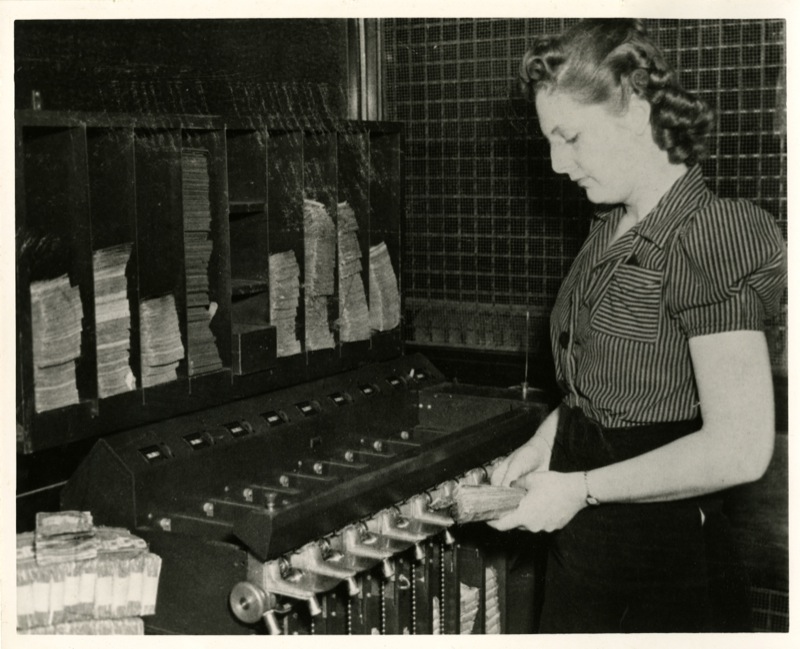
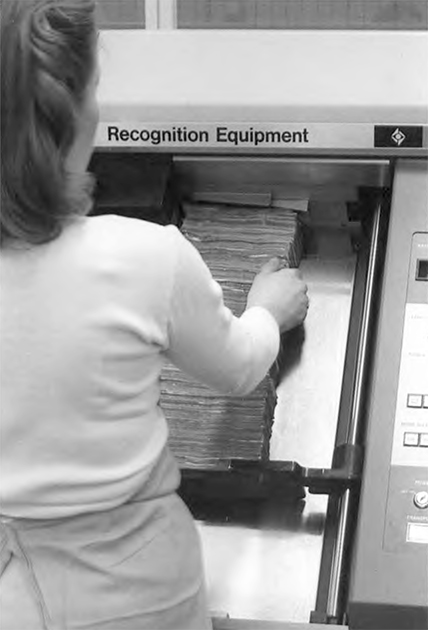
Unfit Currency
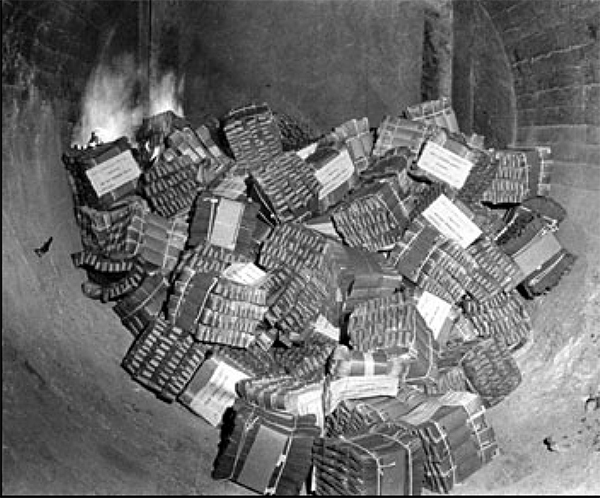
Unfit currency must be destroyed and replaced. Reserve Banks once shipped currency to Washington for incineration. To save on transportation costs, in 1953 the Treasury allowed the destruction of silver certificates to take place on site at Federal Reserve facilities, and later in 1966 Congress amended the Federal Reserve Act to allow on-site destruction of Federal Reserve Notes as well. Reserve Banks built incinerators on site or sought other options; Philadelphia temporarily used a local crematorium for example. However, smoke pollution in the middle of major cities created environmental hazards. Reserve Banks, sometimes nudged by local governments or the Environmental Protection Agency, sought alternatives to burning, including chopping, shredding, or mashing (Joffee 1974). By the early 1980s, the new generation of sorting machines standardized the automatic shredding of unfit notes (Federal Reserve Bank of New York 1982). Shredded notes have been used for a variety of purposes, including compost, cardboard, roofing material, insulation, artificial logs, oil drilling lubrication, cement, novelty items, or burned by electricity generators or placed in landfills.5
One unusual episode of large-scale currency destruction occurred as a result of Hurricane Katrina. Because of water damage and mold, large amounts of currency and coin stored by the Atlanta Fed in its New Orleans branch was rendered unfit for use. In response, the Fed moved currency from other areas, including the Memphis branch of the St. Louis Fed and other offices of the Atlanta Fed (Federal Reserve Bank of Atlanta 2005, p. 14). Forty years earlier, Hurricane Betsy also caused flooding in New Orleans, and the Federal Reserve branch accepted water-soaked currency from banks for attempted drying.

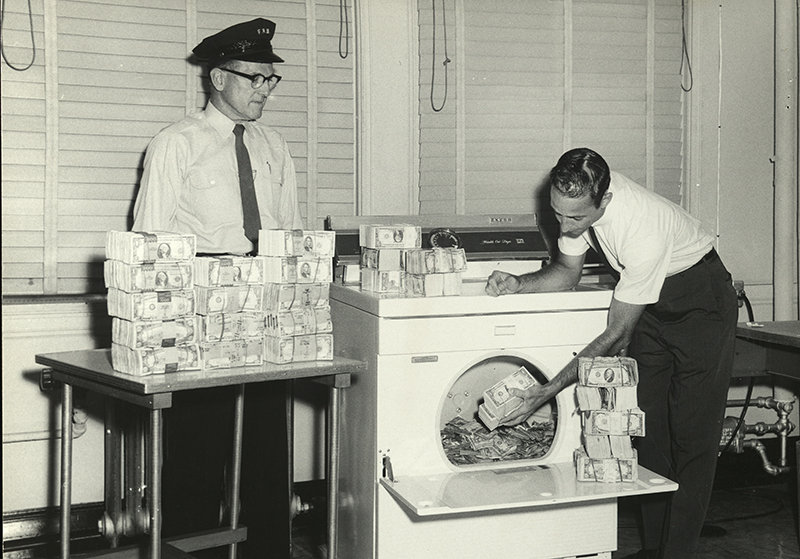
Coin Shortages
Coin shortages have arisen a few times in the Fed's history. A coin shortage in 1951 arose from inadequate supplies of copper and nickel and a strike in the copper industry (Federal Reserve Bank of New York 1951). Another shortage in the mid-1960s developed as a result of growing demand from economic activity and numismatic interest in half-dollars bearing John F. Kennedy's image (Bopp 1964, Federal Reserve Bank of Cleveland 1967, p. 18). The supply of coins was also complicated by the Treasury selling its silver stockpile amidst rising silver prices (Board of Governors 1964, Laurent 1971). More recently, the COVID-19 pandemic led to another coin shortage in 2020, as Americans reduced the amount of coins they put back into circulation (FRFS 2022). To respond to these episodes, the Fed and the Treasury have typically urged members of the public to return coins into the system, increased production, released reserves of coins, and ultimately rationed coins if necessary.
An Elastic Currency in a Changing Financial System
Pre-Fed sources of currency supply were often inadequate in the face of large increases in demand, such as during seasonal changes in economic activity or during financial panics. US Treasury note and certificate issuance was fixed by statute or limited by the amount of gold or silver it held. National Bank note issuance was an individual decision by each bank and was limited by law according to the amount of US government bonds each bank held.
Compared with the pre-1913 currency system, Federal Reserve notes were intended to be more elastic. Depository institutions can obtain currency by withdrawing funds on deposit with the Fed, and the Fed can make additional liquidity available through the discount window and through open market purchases of assets.
Federal Reserve notes are liabilities of the Reserve Banks and are collateralized by the assets of the Reserve Banks. When the Fed was established, public debate about currency reform often focused on the appropriate collateral for currency. Originally, Federal Reserve notes were required to be collateralized by commercial paper or gold, under the theory that changing volumes of commercial paper would furnish an elastic currency by naturally adjusting with the volume of economic activity. Federal Reserve note volumes were also limited to 2.5 times the amount of gold held by the Fed as an additional check on excess issuance and given the historic context of the gold standard (Bordo and Wheelock 2011). The focus on commercial paper was abandoned during the Great Depression. In 1932 the Glass-Steagall Act broadened the type of collateral that could back Federal Reserve Notes to include US government bonds, to help ensure the Fed's ability to meet the public's demand for cash. Likewise, the gold standard no longer guides the international monetary system. The limit on Federal Reserve notes was increased to four times the amount of gold held by the Fed in June 1945 and the limit was eliminated altogether in 1968.
Paper currency is no longer as important a means of payment as it was in the early 20th century. Checks transitioned into common retail use after World War II, especially for larger payments, and electronic payment options have been introduced, including debit and credit cards and ACH payments. Federal Reserve officials have often discussed whether a cashless society might develop (Keeley 1988). Yet, cash has remained an important payment mechanism. In 1984, 14 percent of American families used cash exclusively, and on average families used cash for 36 percent of payments (by value) (Avery et al. 1986). The COVID-19 pandemic accelerated the adoption of non-cash payments, but about 20 percent of consumer payments (by number) were still cash-based in 2022 (Cubides and O'Brien 2022).
As cash usage continues to decline, consumers could potentially benefit from the option of digitized central bank money in the form of a central bank digital currency (CBDC). A CBDC could also pose certain risks. As of 2023, the Federal Reserve has made no decision on issuing a CBDC, but has sought to foster a public dialogue about CBDCs in general and the potential benefits and risks of a US CBDC.
Endnotes
- 1 The Civil War prompted the federal government to begin issuing paper currency. All currency issued by the US government since then remains valid. United States notes, known as "greenbacks," were first authorized in 1862 and by law were legal tender for all debts, public and private. United States notes are redeemable at face value by the Department of the Treasury but not directly backed by gold or silver. Gold certificates were first authorized in 1863 and were generally used by financial institutions for settlement. Silver certificates were later authorized in 1878 in response to the Free Silver movement that called for increasing the money supply by using silver to back new note issuance. In addition, a small amount of Treasury notes of 1890, also backed by silver, still circulated at the time the Fed was established. See Bureau of Engraving and Printing, Currency Notes.
- 2 See Banking and Monetary Statistics volume I (1914-1941) and volume II (1941-1970) for data and further discussion on currency in circulation.
- 3 The Federal Reserve once also possessed an obscure authority to issue Federal Reserve Bank Notes, in addition to Federal Reserve Notes. This authority was little used and eliminated in 1945. See Noll 2011 for a description of this brief but interesting episode.
- 4 Figures on notes received and counted are from the Annual Report of the Board of Governors.
- 5 These uses for shredded Federal Reserve notes were described by the Federal Reserve Bank of Dallas 1971 annual report; Federal Reserve Bank of New York (1982); Wall Street Journal, "Treasury Officials Have Money to Burn But Generally Don't," August 20, 1980, p. 1; Baltimore Sun, "Junking Spent Dollars- Down to the Last Shred," October 4, 1981, p. M2; and Federal Reserve Bank of Boston, "When Bills go bad: what happens when cash is no longer fit for commerce?" Available online
References
Avery, Robert B, Gregory E. Elliehausen, Arthur B. Kennickell, and Paul A. Spindt. "The Use of Cash and Transaction Accounts by American Families." Federal Reserve Bulletin, February 1986. Available on FRASER.
Board of Governors of the Federal Reserve System. "Statement Concerning the Coin Shortage." Federal Reserve Bulletin, July 1964. Available on FRASER.
Board of Governors of the Federal Reserve System. "The Automated Currency Processing System." Annual Report: Budget Review, 1988-1989. Available on FRASER.
Bordo, Michael D. and David C. Wheelock, "The Promise and Performance of the Federal Reserve as Lender of Last Resort 1914-1933," in The Origins, History, and Future of the Federal Reserve: A Return to Jekyll Island. ed. Michael D. Bordo and William Roberds, New York: Cambridge University Press, 2013.
Booth, George. Currency and Coin Responsibilities of the Federal Reserve: A Historical Perspective. Federal Reserve Bank of Cleveland, 1992. Available on FRASER.
Bopp, Karl R. Statement Before the Subcommittee on Legal and Monetary Affairs of the House Committee on Government Operations, US Congress, July 1, 1964. Available on FRASER.
Bureau of Engraving and Printing. Currency Notes, n.d. Available online.
Cubides, Emily and Shaun O'Brien. "2022 Findings from the Diary of Consumer Payment Choice." Federal Reserve Bank of San Francisco, May 5, 2022. Available online.
Federal Reserve Bank of Atlanta. Annual Report, 2005. Available on FRASER.
Federal Reserve Bank of Cleveland. Annual Report, 1967. Available on FRASER.
Federal Reserve Bank of New York. "Coin Shortage." Circular No. 3765, September 28, 1951. Available on FRASER.
Federal Reserve Bank of New York. Federal Reserve Cash on the Move, 1982. Available on FRASER.
Federal Reserve Financial Services (FRFS). "U.S. Coin Circulation: The Path Forward." October 2022. Available online.
Joffee, Robert. "Smoky Problem of Burning Money." Washington Post, July 14, 1974: K1.
Keeley, Michael C. "A Cashless Society?" FRBSF Weekly Letter. April 15, 1988. Available on FRASER.
Lacks, Stanley B. "Mechanization of Coin and Currency Handling." Federal Reserve Bank of Boston, June 1960.
Laurent, Robert D. "The growing appetite for cash." Federal Reserve Bank of Chicago Business Conditions, April 1971. Available on FRASER.
Noll, Franklin. "Federal Reserve Bank Notes: Forgotten Currency." Financial History. Winter 2011.
Weber, Warren. "Government and Private E-Money-Like Systems: Federal Reserve Notes and National Bank Notes." Federal Reserve Bank of Atlanta, CenFIS Working Paper No. 15-03, August 2015. Available on FRASER.
Published December 11, 2023. Jonathan Rose contributed to this article. Please cite this essay as: Federal Reserve History. "Cash Services." December 11, 2023. See disclaimer and update policy.

